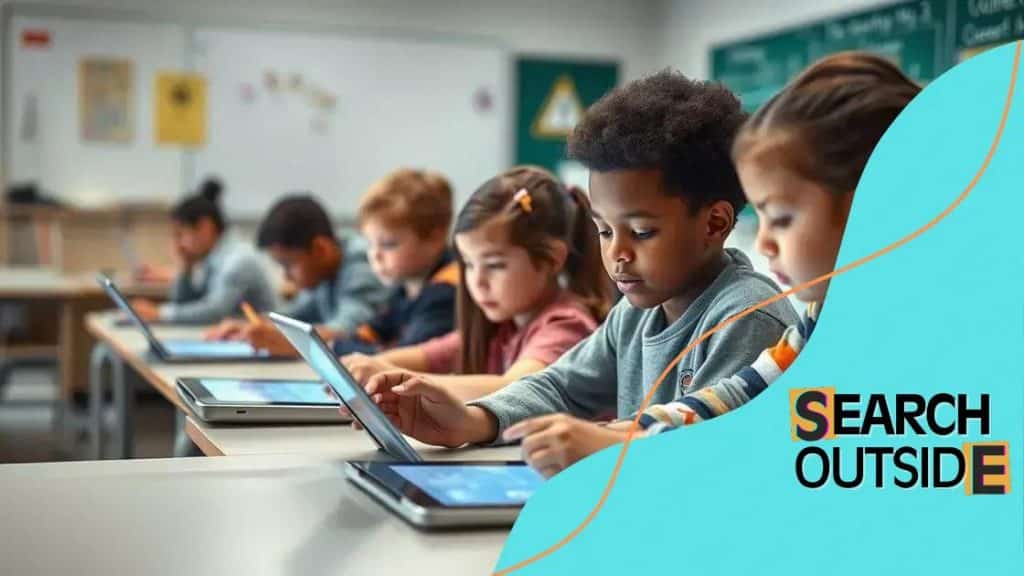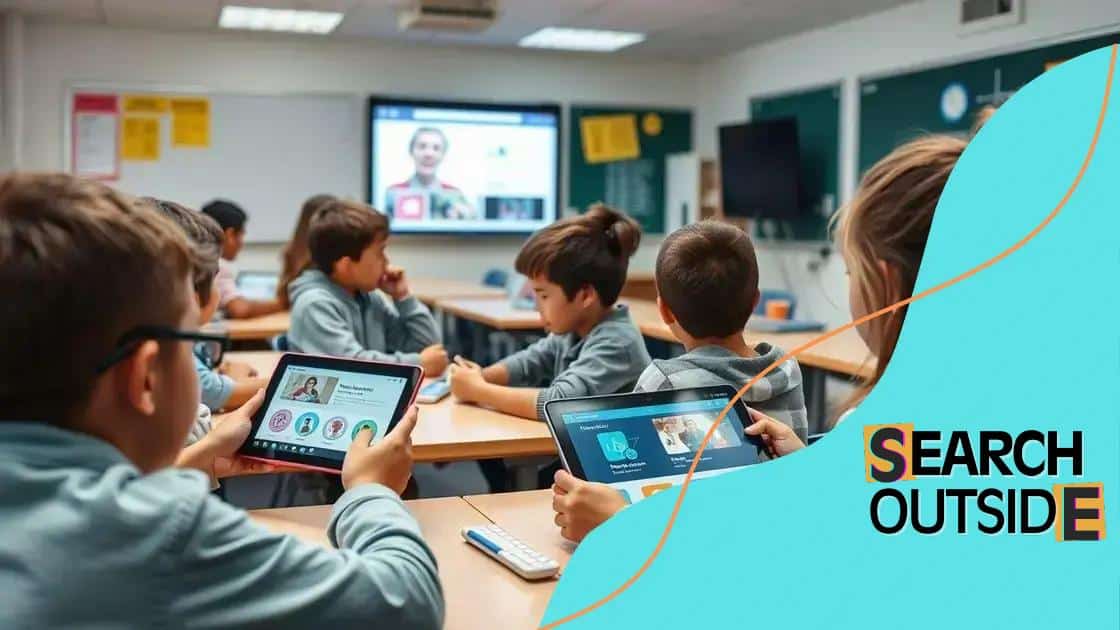How AI is reshaping personalized learning experiences

AI is reshaping personalized learning experiences by tailoring educational content to individual student needs, enhancing engagement through interactive tools, and utilizing data analytics for proactive interventions.
How AI is reshaping personalized learning experiences is a question that many educators are exploring. With technology evolving rapidly, it’s fascinating to think about how tailored education can enhance student engagement and success. What if your learning could adapt to fit your unique style?
Understanding personalized learning
Understanding personalized learning is key in today’s educational landscape. This approach tailors education to fit each student’s needs, allowing for a more engaging and effective learning experience.
With personalized learning, educators can address different learning styles and paces. This is particularly powerful when technology is integrated into the process. By utilizing artificial intelligence, schools can create customized pathways that empower students to learn at their own speed.
How Personalized Learning Works
This method uses data to understand individual student strengths and weaknesses. Teachers can then adapt lessons to better suit each learner, providing the right support and challenges.
- Tools like learning management systems help track progress.
- AI analyzes student performance to recommend resources.
- Regular feedback keeps students informed about their growth.
In practice, personalized learning can look different across classrooms. For instance, some schools utilize adaptive software that changes content based on student interaction.
Benefits of Personalized Learning
The main advantage of personalized learning is increased student motivation. When learners see progress, they are more likely to stay engaged. Moreover, customized learning paths can help struggling students catch up, while advanced learners can explore topics in more depth.
- Enhances understanding of complex subjects.
- Encourages self-directed learning.
- Increases students’ confidence in their abilities.
As more educators embrace this approach, they realize that every student has unique needs. By focusing on personalized learning, we can foster an environment where each child can thrive.
Ultimately, this method not only benefits students but also helps teachers become more effective. By understanding their students better, educators can create lessons that resonate, leading to better outcomes for everyone involved.
The role of AI in education
The role of AI in education is becoming increasingly significant as technology advances. By integrating artificial intelligence into learning environments, educators can create more dynamic and effective strategies for teaching.
One of the main ways AI enhances education is through intelligent tutoring systems. These systems provide personalized feedback and support, allowing students to learn at their own pace. They can adjust the difficulty of questions based on student performance, which keeps learners challenged yet not overwhelmed.
Adaptive Learning Platforms
Adaptive learning platforms are a fantastic example of AI in education. These platforms analyze data from student interactions to customize lessons, helping to cater to different learning styles.
- Students receive tailored resources that fit their needs.
- Teachers get valuable insights into student progress.
- Class time can be used more effectively for group activities.
Moreover, AI-powered assessment tools can quickly grade assignments and provide instant feedback. This not only saves teachers time but also helps students understand their mistakes right away. They can try again with renewed insights, which promotes a growth mindset.
Enhancing Student Engagement
Another exciting aspect of the role of AI in education is its ability to enhance student engagement. For example, virtual reality (VR) and augmented reality (AR) applications powered by AI create immersive learning experiences. Students can explore historical sites or conduct science experiments in a virtual space, making learning more interactive and enjoyable.
This interactive approach helps to maintain student interest and can lead to better retention of information. They are more likely to remember what they learned when they experience it firsthand. As a result, students find it easier to relate to and engage with the material.
Overall, the integration of AI in education can transform traditional classrooms into vibrant learning environments. By embracing technology, educators can better support diverse learners, making education more accessible and effective.
Benefits of AI-driven learning experiences

The benefits of AI-driven learning experiences are numerous and impactful. By integrating artificial intelligence into education, we can significantly improve how students learn and interact with content.
First, AI can create highly personalized learning environments. Each student has different strengths and weaknesses, and AI can analyze this data to tailor lessons that fit individual needs. As a result, learners progress at their own pace, ensuring they grasp concepts before moving on.
Increased Engagement
One major advantage is that AI keeps students engaged. Interactive tools powered by AI can make learning fun and enjoyable. When students are actively participating and having fun, they are more likely to retain information.
- Gamified learning experiences motivate students to participate.
- AI tutors provide instant feedback, which keeps students on track.
- Adaptive learning pathways adjust challenges to match student progress.
Moreover, AI can help educators identify when students are struggling. By analyzing engagement and performance data, teachers can intervene earlier. This proactive approach helps prevent students from falling behind.
Efficiency for Educators
Another benefit of AI-driven learning is the efficiency it brings to educators. With AI, teachers can automate routine tasks like grading and attendance tracking, allowing them to focus on teaching. Less time spent on administrative tasks means more time for meaningful interactions with students.
- AI tools efficiently score assignments, providing quick results.
- Teachers receive analytics on class performance, aiding in lesson planning.
- With AI, educators can easily find resources tailored to their teaching style.
Overall, AI-driven learning experiences foster an environment where both students and educators can thrive. By leveraging technology, we can enhance educational outcomes and prepare learners for success in a rapidly changing world.
Challenges of implementing AI in education
Implementing AI in education comes with various challenges that must be addressed for successful integration. While the benefits are significant, understanding these hurdles is essential for educators and administrators alike.
One major challenge is the cost of technology. Many schools and institutions may struggle to afford the initial investment in AI tools. This includes not only the software but also the necessary hardware to support these technologies. Without proper funding, it can be difficult to provide every student with access to AI-driven learning experiences.
Training and Professional Development
Another issue is the need for training teachers to effectively use AI tools. Many educators may not feel comfortable with technology, and without adequate training, the benefits of AI in education may not be fully realized.
- Professional development programs must be implemented.
- Teachers need ongoing support to adapt to new tools.
- Collaboration among educators can help share best practices.
Additionally, there are concerns about data privacy. Schools must ensure that student data is protected and used responsibly. Parents and educators alike want assurance that their students’ information is safe from misuse. Clear policies and practices must be established to address these privacy issues.
Equity and Access
Equity is another critical challenge. Not all students have the same access to technology at home, which can lead to disparities in learning opportunities. AI systems should be designed to address these differences, providing support to underserved populations.
- Schools should find ways to provide resources to all students.
- Community partnerships can enhance technology access.
- Policies need to promote equity in technology use.
Finally, the rapid pace of technological change can be overwhelming. Educational institutions must continuously adapt to new advancements in AI. This requires a commitment to ongoing evaluation and innovation in teaching practices.
Future trends in personalized learning
The future trends in personalized learning are exciting and promising. As technology continues to evolve, so do the ways educators can tailor learning experiences to meet individual student needs.
One emerging trend is the use of predictive analytics. By analyzing data from student performance, teachers can foresee which students may struggle and intervene early. This proactive approach helps to ensure that no student falls behind.
Integration of Virtual Reality
Another trend is the increasing use of virtual reality (VR) and augmented reality (AR) in personalized learning. These technologies allow students to explore complex concepts in a more immersive way. For instance, a history lesson could transform into a virtual tour of ancient Rome, making learning more engaging and interactive.
- VR can provide hands-on experiences in science classes.
- AR can overlay information in real-world settings for better understanding.
- Both tools can increase student motivation and curiosity.
Moreover, the rise of artificial intelligence in personalized learning is set to change the landscape further. AI can help create customized lessons that adapt in real time based on student interactions. This means that educational content can be tailored not only to learning styles but to personal interests as well.
Collaboration Tools
Collaboration tools are also becoming essential. They enable students to connect with peers worldwide, fostering a global learning environment. In these collaborative settings, students can share insights and perspectives, which enriches the learning experience.
- Students can work on projects with classmates from different countries.
- Collaboration encourages critical thinking and problem-solving.
- Peer feedback can enhance understanding and engagement.
These future trends in personalized learning highlight the importance of technology in education. As these innovations are introduced, they can lead to a more inclusive and effective learning environment for all students.
AI in personalized learning presents exciting opportunities for the future of education. With technology rapidly evolving, students can benefit from tailored learning experiences that meet their individual needs. As we advance, it is essential to address the challenges of implementation, such as cost and data privacy, while embracing innovations like virtual reality and collaboration tools. By focusing on these areas, we can create an engaging and effective educational environment for all learners. The future of personalized learning is bright, filled with endless possibilities for growth and success.
FAQ – Frequently Asked Questions about AI in Personalized Learning
How does AI enhance personalized learning experiences?
AI uses data to tailor educational content to each student’s needs, helping them learn at their own pace.
What challenges do schools face when implementing AI technologies?
Schools often struggle with funding, teacher training, and ensuring data privacy while adopting AI tools.
Can AI improve student engagement in the classroom?
Yes, AI-driven tools create interactive and personalized lessons that keep students more engaged and motivated.
What are the future trends in AI for education?
Future trends include the use of predictive analytics, virtual reality, and collaboration tools to enhance learning.





